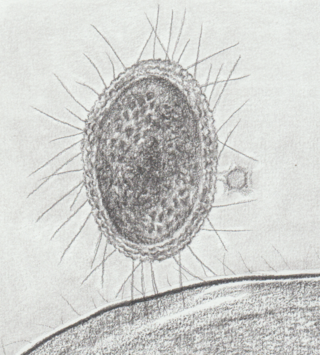
Nanoarchaeota is a proposed phylum in the domain Archaea that currently has only one representative, Nanoarchaeum equitans, which was discovered in a submarine hydrothermal vent and first described in 2002.

Euryarchaeota is a phylum of archaea. Euryarchaeota are highly diverse and include methanogens, which produce methane and are often found in intestines, halobacteria, which survive extreme concentrations of salt, and some extremely thermophilic aerobes and anaerobes, which generally live at temperatures between 41 and 122 °C. They are separated from the other archaeans based mainly on rRNA sequences and their unique DNA polymerase.
The Thermoprotei is a class of the Thermoproteota.

In taxonomy, the Thermoplasmata are a class of the Euryarchaeota.

In the taxonomy of microorganisms, the Methanomicrobia are a class of the Euryarchaeota.

Archaeal Richmond Mine acidophilic nanoorganisms (ARMAN) were first discovered in an extremely acidic mine located in northern California (Richmond Mine at Iron Mountain) by Brett Baker in Jill Banfield's laboratory at the University of California Berkeley. These novel groups of archaea named ARMAN-1, ARMAN-2 (Candidatus Micrarchaeum acidiphilum ARMAN-2), and ARMAN-3 were missed by previous PCR-based surveys of the mine community because the ARMANs have several mismatches with commonly used PCR primers for 16S rRNA genes. Baker et al. detected them in a later study using shotgun sequencing of the community. The three groups were originally thought to represent three unique lineages deeply branched within the Euryarchaeota, a subgroup of the Archaea. However, based on a more complete archaeal genomic tree, they were assigned to a new superphylum named DPANN. The ARMAN groups now comprise deeply divergent phyla named Micrarchaeota and Parvarchaeota. Their 16S rRNA genes differ by as much as 17% between the three groups. Prior to their discovery, all of the Archaea shown to be associated with Iron Mountain belonged to the order Thermoplasmatales (e.g., Ferroplasma acidarmanus).
Chloracidobacterium is a genus of the Acidobacteriota. It is currently assigned to the family Acidobacteriaceae, but phylogenetic evidence suggests that it belongs in Blastocatellia.

The Nitrososphaerota are a phylum of the Archaea proposed in 2008 after the genome of Cenarchaeum symbiosum was sequenced and found to differ significantly from other members of the hyperthermophilic phylum Thermoproteota. Three described species in addition to C. symbiosum are Nitrosopumilus maritimus, Nitrososphaera viennensis, and Nitrososphaera gargensis. The phylum was proposed in 2008 based on phylogenetic data, such as the sequences of these organisms' ribosomal RNA genes, and the presence of a form of type I topoisomerase that was previously thought to be unique to the eukaryotes. This assignment was confirmed by further analysis published in 2010 that examined the genomes of the ammonia-oxidizing archaea Nitrosopumilus maritimus and Nitrososphaera gargensis, concluding that these species form a distinct lineage that includes Cenarchaeum symbiosum. The lipid crenarchaeol has been found only in Nitrososphaerota, making it a potential biomarker for the phylum. Most organisms of this lineage thus far identified are chemolithoautotrophic ammonia-oxidizers and may play important roles in biogeochemical cycles, such as the nitrogen cycle and the carbon cycle. Metagenomic sequencing indicates that they constitute ~1% of the sea surface metagenome across many sites.

Bacterial phyla constitute the major lineages of the domain Bacteria. While the exact definition of a bacterial phylum is debated, a popular definition is that a bacterial phylum is a monophyletic lineage of bacteria whose 16S rRNA genes share a pairwise sequence identity of ~75% or less with those of the members of other bacterial phyla.
Armatimonadota is a phylum of gram-negative bacteria.
Nanohaloarchaea is a clade of diminutive archaea with small genomes and limited metabolic capabilities, belonging to the DPANN archaea. They are ubiquitous in hypersaline habitats, which they share with the extremely halophilic haloarchaea.

DPANN is a superphylum of Archaea first proposed in 2013. Many members show novel signs of horizontal gene transfer from other domains of life. They are known as nanoarchaea or ultra-small archaea due to their smaller size (nanometric) compared to other archaea.

Atribacterota is a phylum of bacteria, which are common in anoxic sediments rich in methane. They are distributed worldwide and in some cases abundant in anaerobic marine sediments, geothermal springs, and oil deposits. Genetic analyzes suggest a heterotrophic metabolism that gives rise to fermentation products such as acetate, ethanol, and CO2. These products in turn can support methanogens within the sediment microbial community and explain the frequent occurrence of Atribacterota in methane-rich anoxic sediments. According to phylogenetic analysis, Atribacterota appears to be related to several thermophilic phyla within Terrabacteria or may be in the base of Gracilicutes. According to research, Atribacterota shows patterns of gene expressions which consists of fermentative, acetogenic metabolism. These expressions let Atribacterota to be able to create catabolic and anabolic functions which are necessary to generate cellular reproduction, even when the energy levels are limited due to the depletion of dissolved oxygen in the areas of sea waters, fresh waters, or ground waters.

The candidate phyla radiation is a large evolutionary radiation of bacterial lineages whose members are mostly uncultivated and only known from metagenomics and single cell sequencing. They have been described as nanobacteria or ultra-small bacteria due to their reduced size (nanometric) compared to other bacteria.
Modulibacteria(Moduliflexota) is a bacterial phylum formerly known as KS3B3 or GN06. It is a candidate phylum, meaning there are no cultured representatives of this group. Members of the Modulibacteria phylum are known to cause fatal filament overgrowth (bulking) in high-rate industrial anaerobic wastewater treatment bioreactors.

NC10 is a bacterial phylum with candidate status, meaning its members remain uncultured to date. The difficulty in producing lab cultures may be linked to low growth rates and other limiting growth factors.
Nitrospinota is a bacterial phylum. Despite only few described species, members of this phylum are major nitrite-oxidizing bacteria in surface waters in oceans. By oxidation of nitrite to nitrate they are important in the process of nitrification in marine environments.
Natrialbales is an order of halophilic, chemoorganotrophic archaea within the class Haloarchaea. The type genus of this order is Natrialba.










